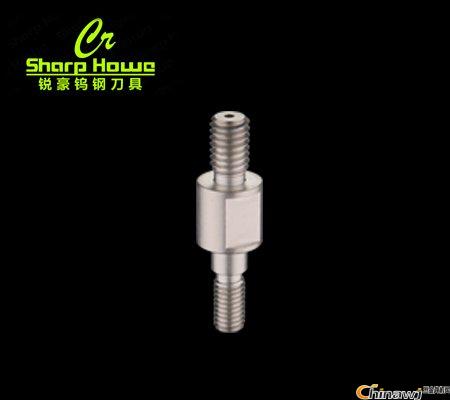With the advancement of science and technology and process production, the materials are getting higher and higher, and the materials for cutting tools are also more complicated. The cutting speed needs to be continuously improved, and the conventional ordinary tools can no longer meet the latest requirements, which requires more in-depth study of the tool technology. Although various means can be used to improve the hardness and wear resistance of the tool material, it also reduces the strength and toughness of the tool, thereby affecting the performance of the machined parts. Carbide tool http://The wear resistance of the tool lies in the surface quality. The main means to improve the surface quality is to surface the tool surface. Surface heat treatment is divided into two categories, one is surface quenching and tempering heat treatment, and the other is chemical heat treatment. How to test the hardness of tool surface treatment? Take a look. 1. Surface quenching and tempering heat treatment surface quenching, tempering heat treatment is usually carried out by induction heating or flame heating. The main technical parameters are surface hardness, local hardness and effective hardened layer depth. The hardness test can be carried out using a Vickers hardness tester or a Rockwell or surface Rockwell hardness tester. The choice of test force (scale) is related to the effective hardened layer depth and the surface hardness of the workpiece. The Vickers hardness tester is an important means to test the surface hardness of heat-treated workpieces. It can be tested with a test force of 0.5-100KG to test a surface hardened layer as thin as 0.05MM thick. Its precision is the highest, and the surface hardness of the heat-treated workpiece can be distinguished. Minor differences. In addition, the effective hardened layer depth is also measured by a Vickers hardness tester. Therefore, it is necessary to equip a unit for surface heat treatment or a large number of surface heat treatment workpieces with a Vickers hardness tester. The surface Rockwell hardness tester is also very suitable for testing the hardness of surface hardened workpieces. The surface Rockwell hardness tester has three scales to choose from. Various surface hardened workpieces with effective hardening depths in excess of 0.1 mm can be tested. Although the accuracy of the surface Rockwell hardness tester is not as high as the Vickers hardness tester, it has been able to meet the requirements as a means of quality management and inspection of the heat treatment plant. Moreover, it has the characteristics of simple operation, convenient use, low price, rapid measurement, and direct reading of hardness value. The surface Rockwell hardness tester can be used for rapid and non-destructive part-by-piece inspection of batch surface heat treatment workpieces. This is important for metalworking and mechanical manufacturing plants. When the surface heat-treated hardened layer is thick, a Rockwell hardness tester can also be used. When the thickness of the heat-treated hardened layer is 0.4-0.8 MM, the HRA scale can be used. When the thickness of the hardened layer exceeds 0.8 MM, the HRC scale can be used. Vickers, Rockwell and Surface Rockwell values ​​can be easily converted to each other and converted to standard, drawing or user-required hardness values. 2. Chemical Heat Treatment Chemical heat treatment is the atomization of the surface of a workpiece into one or several chemical elements, thereby changing the chemical composition, structure and properties of the surface of the workpiece. After quenching and low temperature tempering, the surface of the workpiece has high hardness, wear resistance and contact fatigue strength, and the core of the workpiece has high toughness. The main technical parameters of the chemically heat treated workpiece are the hardened layer depth and surface hardness. The depth of the hardened layer is still to be measured with a Vickers hardness tester. Detect the distance from the surface of the workpiece to the point where the hardness drops to 50 HRC. This is the effective hardening depth. The surface hardness test of the chemically heat treated workpiece is similar to the hardness test of the surface hardened heat treatment workpiece, and can be detected by a Vickers hardness tester, a surface Rockwell hardness tester or a Rockwell hardness tester, except that the thickness of the nitriding thickness is thin, generally not more than 0.7MM, then you can no longer use the Rockwell hardness tester. 3. Local heat-treated parts If the local hardness requirements are high, local hardening heat treatment can be carried out by means of induction heating. Such parts are usually marked with local quenching heat treatment position and local hardness value on the drawings. The hardness test of the tungsten steel anti-vibration tool holder http:// part is to be carried out in the designated area. The hardness testing instrument can use the Rockwell hardness tester to test the HRC hardness value. If the heat treatment hardened layer is shallow, the surface Rockwell hardness tester can be used to test the HRN hardness value. The method of surface treatment of the tool and the method of measuring the hardness of the surface are described in detail. When testing the quality of the tool, there is also a hardness standard. This is just a performance that an excellent tool needs to have, as well as the accuracy of the tool, the wear resistance, etc., which need to be strictly controlled, and the development of the tool cannot be stopped. Http://news.chinawj.com.cn 

Media Facade Lighting,Led Grid Screen Lighting,Flexible Transparent Mesh Lighting,Building Lighting
Shen zhen SH LED Technology Co.,Ltd , https://www.pixellightsolutions.com